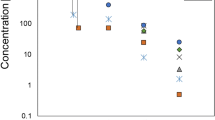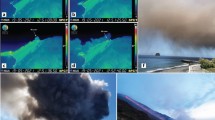Abstract
Explosive volcanic eruptions can have severe impacts on watershed hydrology. Among them, surface crusting of volcanic ash fallout following rainfall has been shown to favour runoff, erosion and lahar initiation. It may also hamper seed emergence and depress plant growth. However, ash crust formation is poorly understood. Reconstructed ash deposits were subjected to simulated rainfall to investigate the microscale morphological modifications of the ash deposit surface in response to raindrop impact. Ash samples from three volcanic eruptions (Mt. Merapi, MER, Indonesia; Eyjafjallajökull, EYJA, Iceland; and San Cristobal, SC, Nicaragua) with different particle size distributions and soluble salt contents were used in the experiment. Microcraters and micropeaks formed on the surface of all ash deposits after rainfall initiation. This was accompanied by fine material (also referred to as micromass) accumulation in the form of one or several layers, a few tens to hundreds of micrometres thick. Such morphological changes point to structural crust formation. The crusts consisted of a thin layer of tightly packed clay and silt-size ash particles (SC), overlain by loose coarser materials in micro-craters (MER) or by an almost continuous coarse-grained layer (EYJA). In all cases, the surface crust had a reduced porosity compared with the bulk material. Depending on ash particle size, crusting was governed by splash, compaction and vertical sorting (MER), vertical particle sorting (EYJA) or compaction (SC). No samples showed evidence of particle cementation through secondary salt precipitation. Our results shed new light on the mechanisms responsible for post-depositional crusting of a natural ash deposit.











Similar content being viewed by others
References
Al-Durrah MM, Bradford JM (1982) The mechanism of raindrop splash on soil surfaces 1. Soil Sci Soc Am J 46:1086–1090
Antos JA, Zobel DB (2005) Plant responses in forests of the tephra-fall zone. In: Dale VH, Swanson FJ, Crisafulli CM (eds) Ecological responses to the 1980 eruption of Mount St. Helens. Springer, New York, pp 47–58
Armenise E, Simmons RW, Ahn S, Garbout A, Doerr SH, Mooney SJ, Sturrock CJ, Ritz K (2018) Soil seal development under simulated rainfall: structural, physical and hydrological dynamics. J Hydrol 556:211–219
Arnalds O (2013) The influence of volcanic tephra (ash) on ecosystems. Adv Agron 121:331–380
Assouline S (2004) Rainfall-induced soil surface sealing. Vadose Zone J 3:570–591
Ayris PM, Delmelle P (2012) The immediate environmental effects of tephra emission. Bull Volcanol 74:1905–1936
Baumhardt RL, Schwartz RC (2004) Crusts. In: Hillel D (ed) Encyclopedia of soils in the environment. Elsevier Press, Oxford, pp 347–356
Bielders C, Baveye P (1995a) Processes of structural crust formation on coarse-textured soils. Eur J Soil Sci 46:221–232
Bielders C, Baveye P (1995b) Vertical particle segregation in structural crusts: experimental observations and the role of shear strain. Geoderma 67:247–261
Bielders C, Grymonprez B (2010) Raindrop impact: a neglected but potentially major contributor to particle mobilization in soils. Soil Sci Soc Am J 74:1446–1456
Black RA, Mack RN (1986) Mount St. Helens ash: recreating its effects on the steppe environment and ecophysiology. Ecology 67:1289–1302
Bresson LM, Valentin C (1993) Soil surface crust formation: contribution of micromorphology. Dev Soil Sci 22:737–762
Brown RJ, Bonadonna C, Durant AJ (2012) A review of volcanic ash aggregation. Phys Chem Earth A/B/C 45:65–78
Cook RJ, Barron JC, Papendick RI, Williams GJ (1981) Impact on agriculture of the Mount St. Helens eruptions. Science 211(4477):16–22
Craig H, Wilson T, Stewart C, Villarosa G, Outes V, Cronin S, Jenkins S (2016) Agricultural impact assessment and management after three widespread tephra falls in Patagonia, South America. Nat Hazards 82:1167–1229
Dale VH, Swanson FJ, Crisafulli CM (2005) Disturbance, survival, and succession: understanding ecological responses to the 1980 eruption of Mount St. Helens. In: Dale VH, Swanson FJ, Crisafulli CM (eds) Ecological responses to the 1980 eruption of Mount St Helens. Springer, New York, pp 3–11
Damby DE, Horwell CJ, Baxter PJ, Delmelle P, Donaldson K, Dunster C, Fubini B, Murphy FA, Nattrass C, Sweeney S, Tetley TD, Tomatis M (2013) The respiratory health hazard of tephra from the 2010 centennial eruption of Merapi with implications for occupational mining of deposits. J Volcanol Geotherm Res 261:376–387
Delmelle P, Villiéras F, Pelletier M (2005) Surface area, porosity and water adsorption properties of fine volcanic ash particles. Bull Volcanol 67:160–169
Epstein E, Grant WJ (1973) Soil crust formation as affected by raindrop impact. In: Hadas A, Swartzendruber D, Rijtema PE, Fuchs M, Yaron B (eds) Physical aspects of soil water and salts in ecosystems. Springer, Berlin, Heidelberg, Ecological Studies 4, pp 195–201
Global Volcanism Program (2000) Report on San Cristobal (Nicaragua). In: Wunderman R (ed.), Bulletin of the Global Volcanism Network. Smithsonian Institution, 25:2. http://www.volcano.si.edu/. Accessed 11 May 2018
Gudmundsson MT, Thordarson T, Höskuldsson Á et al (2012) Ash generation and distribution from the April-May 2010 eruption of Eyjafjallajökull, Iceland. Sci Rep 2:572
Hendrayanto KS, Takahisa M, Kosugi K (1995) Hydraulic characteristics of new volcanic ash deposit. J Jpn Soc Hydrol Water Res 8:484–491
Jones MT, Sparks RSJ, Valdes PJ (2007) The climatic impact of supervolcanic ash blankets. Clim Dyn 29:553–564
Jones R, Thomas RE, Peakall J, Manville V (2017) Rainfall runoff properties of tephra: simulated effects of grain-size and antecedent rainfall. Geomorphology 282:39–51
Kinnell PIA (2005) Raindrop-impact-induced erosion processes and prediction: a review. Hydrol Process 19:2815–2844
Leavesley GH, Lusby GC, Lichty RW (1989) Infiltration and erosion characteristics of selected tephra deposits from the 1980 eruption of Mount St. Helens, Washington, USA. Hydrol Sci J 34:339–353
Li Z, Giese RF, Wu W, Sheridan MF, Van Oss CJ (1997) The surface thermodynamic properties of some volcanic ash colloids. J Dispers Sci Technol 18:223–241
Malin MC, Dzurisin D, Sharp RP (1983) Stripping of Keanakakoi tephra on Kilauea volcano, Hawaii. GSA Bull 94:1148–1158
Manville V, Hodgson KA, Houghton BF, Keys JRH, White JDL (2000) Tephra, snow and water: complex sedimentary responses at an active snow-capped stratovolcano, Ruapehu, New Zealand. Bull Volcanol 62:278–293
McHale G, Newton MI, Shirtcliffe NJ (2005) Water repellent soil and its relationship to granularity, surface roughness and hydrophobicity: a materials science view. Eur J Soil Sci 56:445–452
McIntyre DS (1958a) Permeability measurements of soil crusts formed by raindrop impact. Soil Sci 85:185–189
McIntyre DS (1958b) Soil splash and the formation of surface crusts by raindrop impact. Soil Sci 85:261–266
Moore DC, Singer MJ (1990) Crust formation effects on soil erosion processes. Soil Sci Soc Am J 54:1117–1123
Moss AJ (1991) Rain impact soil crust. I. Formation on a granite derived soil. Soil Res 29:271–289
Mualem Y, Assouline S, Rohdenburg H (1990) Rainfall induced soil seal. (A) a critical review of observations and models. Catena 17:185–203
Nammah H, Larsen FE, McCool DK, Fritts R, Molnau M (1986) Mt. St. Helens volcanic ash: effect of incorporated and unincorporated ash of two particle sizes on runoff and erosion. Agric Ecosyst Environ 15:63–72
Pierson TC, Major JJ (2014) Hydrogeomorphic effects of explosive volcanic eruptions on drainage basins. Annu Rev Earth Planet Sci 42:469–507
Poss R, Pleuvret C, Saragoni H (1990) Influence des réorganisations superficielles sur l’infiltration dans les terres de Barre (Togo méridional). Cahiers-ORSTOM Pédologie 25:405–415
Segerstrom K (1950) Erosion studies at Paricutin, state of Michoacan, Mexico. Report, USGS Numbered Series, Bulletin 965-A, pp 1–164
Sigmarsson O, Vlastelic I, Andreasen R, Bindeman I, Devidal JL, Moune S, Keiding JK, Larsen G, Höskuldsson A, Thordarson T (2011) Remobilization of silicic intrusion by mafic magmas during the 2010 Eyjafjallajökull eruption. Solid Earth 2:271–281
Valentin C, Bresson LM (1992) Morphology, genesis and classification of surface crusts in loamy and sandy soils. Geoderma 55:225–245
Waldron HH (1967) Debris flow and erosion control problems caused by the ash eruptions of Irazu volcano, Costa Rica. US Geol Surv Bull 1241:1–37
Yamakoshi T, Suwa H (2000) Post-eruption characteristics of surface runoff and sediment discharge on the slopes of pyroclastic flow deposits, Mount Unzen, Japan. Trans Jpn Geomorphol Union 21:469–497
Acknowledgements
We thank the Departamento de Metalurgia Extractiva, Escuela Politécnica Nacional, Quito, for access to their scanning electron microscope facility. The authors are grateful to an anonymous reviewer and to V. Manville, whose detailed and constructive comments greatly improved the quality of the manuscript. The authors would also like to thank the Associate Editor for his careful and swift handling of this contribution.
Funding
This study was supported by the Marie Curie Initial Training Network “VERTIGO” funded through the European Seventh Framework Program (FP7 2007-13) under Grant Agreement number 607905. I.T. benefited from a UCLouvain complementary PhD studentship (2017-18) funded through the Fonds Spéciaux de Recherche (FSR).
Author information
Authors and Affiliations
Corresponding author
Additional information
Editorial responsibility: P-S. Ross
Electronic supplementary material
ESM 1
(DOCX 1578 kb)
Rights and permissions
About this article
Cite this article
Tarasenko, I., Bielders, C.L., Guevara, A. et al. Surface crusting of volcanic ash deposits under simulated rainfall. Bull Volcanol 81, 30 (2019). https://doi.org/10.1007/s00445-019-1289-6
Received:
Accepted:
Published:
DOI: https://doi.org/10.1007/s00445-019-1289-6




